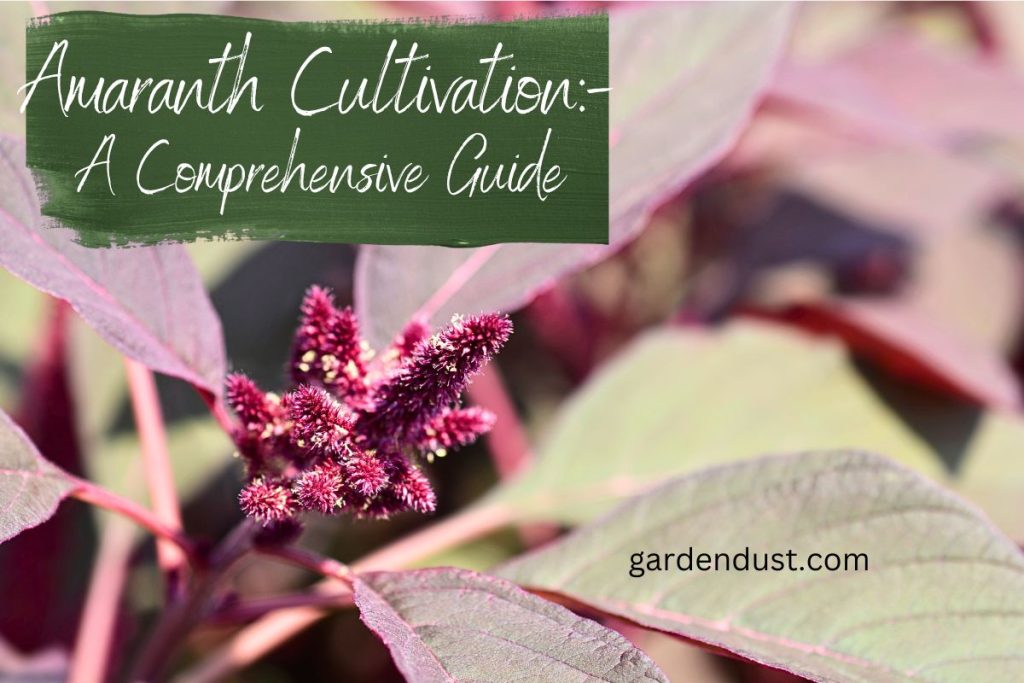In the world of agriculture, few crops boast the remarkable versatility and nutritional value of amaranth. With a history dating back thousands of years, amaranth has regained popularity in recent times due to its exceptional nutritional content and adaptability to diverse growing conditions. This article delves into the intricate Amaranth Cultivation: A Comprehensive Guide to covering everything from its botanical characteristics to planting, care, and harvest.
Botanical Background:-
Amaranth, belonging to the Amaranthaceae family, is a group of annual flowering plants that encompass over 60 species. This diverse genus can be classified into two main categories: grain amaranths and leafy amaranths. While both types share common traits, they are cultivated for different purposes.
Grain amaranths are cultivated primarily for their seeds, which are highly nutritious and comparable to other grains like wheat and rice. Leafy amaranths, on the other hand, are grown for their edible leaves, which are rich in vitamins, minerals, and antioxidants. The most common species cultivated for consumption include Amaranthus cruentus, Amaranthus hypochondriacus, and Amaranthus tricolor.
Cultivation Process of Amaranth :-
Site Selection
Amaranth is a hardy crop that can adapt to various soil types, but it thrives in well-draining, fertile soil with a pH range of 6.0 to 7.5. Choose a sunny location with good air circulation to prevent fungal diseases.
Planting
Amaranth can be grown from both seeds and transplants. Direct seeding is common, with planting depth ranging from 1/8 to 1/4 inch. For transplants, start seeds indoors a few weeks before the last frost, then transplant them when the soil has warmed up.
Spacing
Spacing requirements depend on the specific amaranth variety and its intended use. For grain amaranths, space plants about 12 to 18 inches apart in rows 24 to 36 inches apart. Leafy amaranths can be spaced closer, with around 6 to 12 inches between plants.
Watering
Amaranth prefers consistent moisture, especially during germination and early growth. Once established, it can tolerate some drought, but consistent watering is essential for optimal yield and quality.
Fertilization
Incorporate balanced fertilizers into the soil before planting or use a side-dressing approach during the growing season. Too much nitrogen can lead to excessive foliage growth at the expense of seed production.
Weed Control
Early weed control is crucial, as amaranth seedlings can be easily outcompeted by weeds. Mulching can help suppress weed growth and maintain soil moisture.
Pests and Diseases
Amaranth is generally resistant to pests and diseases. However, be vigilant for common garden pests like aphids and caterpillars. Regular observation and proper cultural practices can prevent most issues.
Harvesting
The timing of harvest depends on the intended use. For grain amaranths, allow the plants to reach full maturity, which is indicated by the seed heads turning from green to a light tan color. Harvest by cutting the entire seed head and allowing it to dry in a well-ventilated area. For leafy amaranths, young leaves can be harvested continuously as soon as the plant has several sets of true leaves.
Nutritional Value And Culinary Uses:-
One of the most compelling aspects of amaranth cultivation is its exceptional nutritional profile. The seeds are rich in protein, dietary fiber, essential amino acids like lysine, and various vitamins and minerals, including iron, magnesium, and calcium. Additionally, amaranth contains compounds like squalene and tocopherols, known for their antioxidant properties.
Grain amaranths can be cooked similarly to other grains, such as rice or quinoa. The seeds can be boiled, toasted, popped, or ground into flour for various culinary applications. Amaranth flour is suitable for baking, adding a nutty flavor and enhancing the nutritional content of baked goods.
Leafy amaranths are commonly used in salads, soups, and stir-fries. They are prized for their vibrant colors and tender leaves, making them a valuable addition to a well-rounded diet.
Common Pests And Problems With Amaranth:-
Amaranth cultivation can face a range of pest and disease challenges. Common pests include aphids, which can distort and stunt plant growth by feeding on sap, as well as caterpillars that consume leaves and affect overall plant health. Grasshoppers can also be problematic, causing damage by chewing on leaves and stems. Additionally, amaranth can be susceptible to fungal diseases such as powdery mildew and downy mildew, which thrive in humid conditions and can lead to defoliation and reduced yields. To combat these issues, implementing integrated pest management practices, including regular inspection, proper spacing, and, if necessary, judicious use of organic pesticides, is crucial to ensuring a successful and productive amaranth crop.
Final Thoughts
Amaranth cultivation offers a rewarding experience for both home gardeners and commercial farmers. Its adaptability, nutritional value, and diverse culinary applications make it a standout crop in the world of sustainable agriculture. By following the proper cultivation techniques outlined in this article, individuals can enjoy a bountiful harvest of nutrient-rich amaranth seeds or delicious leafy greens. Whether grown for personal consumption or commercial purposes, amaranth stands as a testament to the potential of traditional crops to meet the modern demand for nutritious and sustainable food sources. Happy Gardening….






